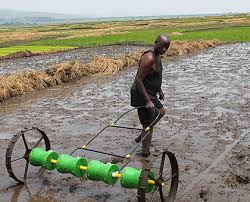 Rice farmers in Mwea area of Central Kenya have adopted a modest technology of sowing rice seeds which has cut costs by upto 60 percent while reducing seed wastage by 90 percent.
Rice farmers in Mwea area of Central Kenya have adopted a modest technology of sowing rice seeds which has cut costs by upto 60 percent while reducing seed wastage by 90 percent.
One of their own Albert Njihia a rice farmer from Mwea had gone on a farmer exchange programme in Bangladesh and was struck by an easier to make technology dubbed drum seeder that farmers in rice paddies were using to plant rice. With help from Bridge Net Africa a not for profit Organization that has been helping farmers in Mwea constituency he set out to reconstruct the drum seeder and two years on about 300 farmers are now sharing about 10 of the seeders that have been constructed.
For generations, farmers have been planting rice by tossing handfuls of seed into a field until it is covered. Unfortunately, this inexact method causes unequal seed distribution, which reduces yields and limits farmer income. The drum seeder is a simple piece of equipment that has transformed the way farmers sow their fields. The design is straightforward and easy to use. A series of plastic drums containing seed is linked horizontally with wheels on both ends. The farmer stands in a harness and pulls the unit behind him, dispensing seed up to 16 rows at a time.
This modest technology allows farmers to plant crops in evenly-spaced rows, ensuring they get the most out of their fertilizer and avoid wasting seed, which in turn leads to significant improvements in crop yield and quality. By reducing production costs and improving yields, drum seeders have had a significant impact on farmers’ incomes and livelihoods.
Economists doing a survey on the efficacy of the seeder over traditional rice planting methods say that it has reduced labor costs by about Sh5000 per hectare and increase crop yield by 5-10 percent. “This is mainly due to the fact that the seeder requires a maximum of two farmers to operate compared to over 10 labourers who were hired to broadcast the seeds before. Again there is little or no seed wastage since all the seeds are evenly distributed in the rows,” says Michael Odong an agricultural economist with Sandim Investments who were carrying the survey.
Rachel Waceke is among the farmers who are using the seeder. Since there are only 10 seeders among 300 farmers they are divided into farmer groups of 30 members. Each member gets the seeder for two days and pays some Sh100 for the maintenance of the seeder. “I only spend a hundred shilling and within two days I have already planted my 3 acres of land. It is very accurate in broadcasting seeds. I was choking trying to pay all my labourers who would even take a whole week planting. Again because of careless broadcasting of the seeds upon harvesting I would find rice hadn’t grown in some patches but since I started using the seeder rice in my fields has grown uniformly,” she says.
It is these success stories that are now motivating Albert to introduce the seeder to other rice growing areas as he looks for even more ways of adopting it for planting other crops. “I hope we can manage to e model it to be used in planting the staple crops in Kenya like maize, beans and potatoes. It would be every farmer’s dream,” he says.
















Comments powered by CComment